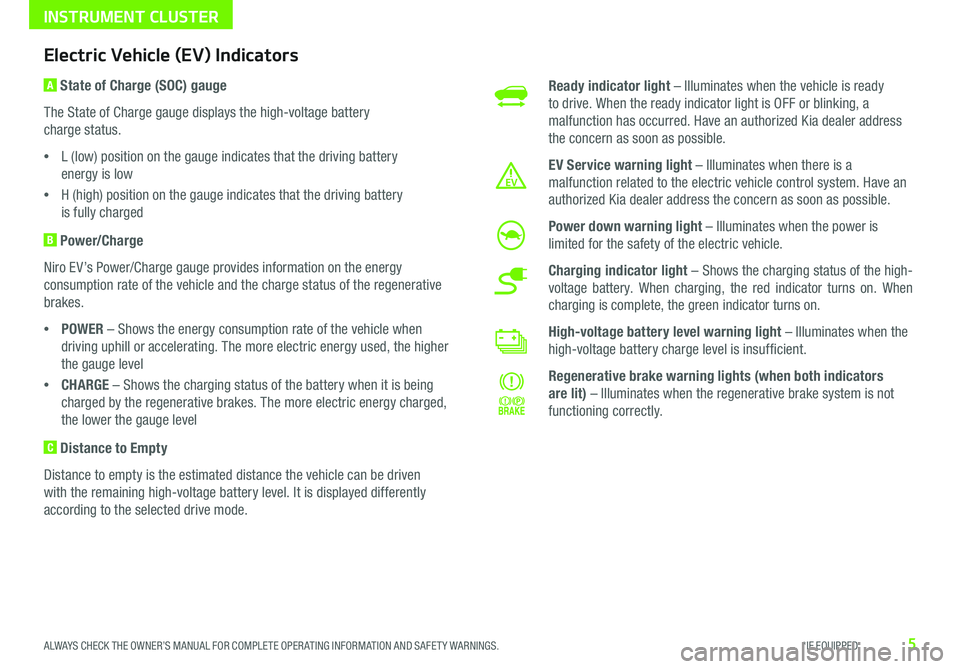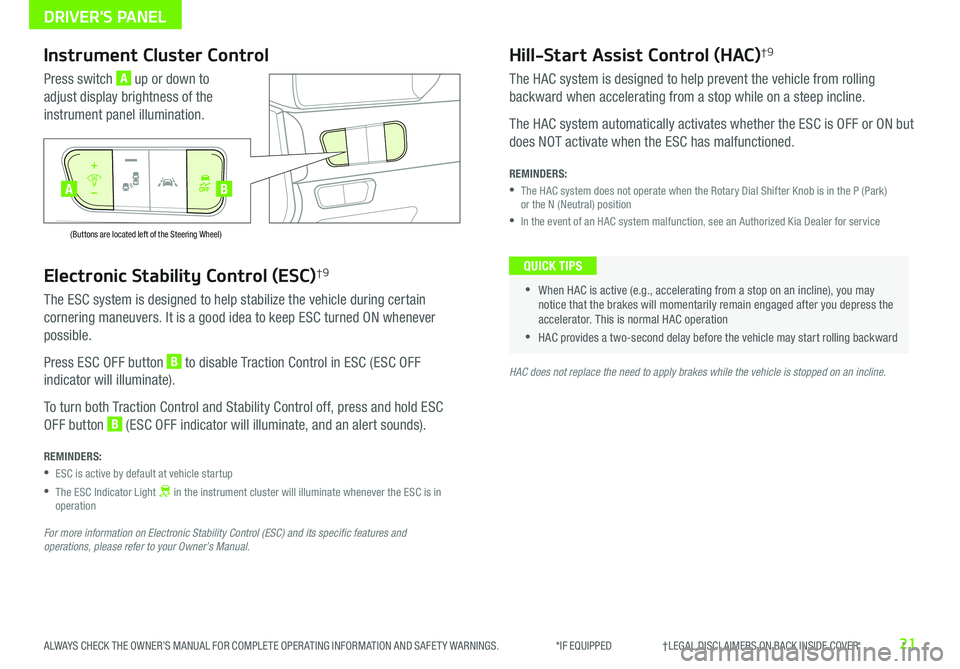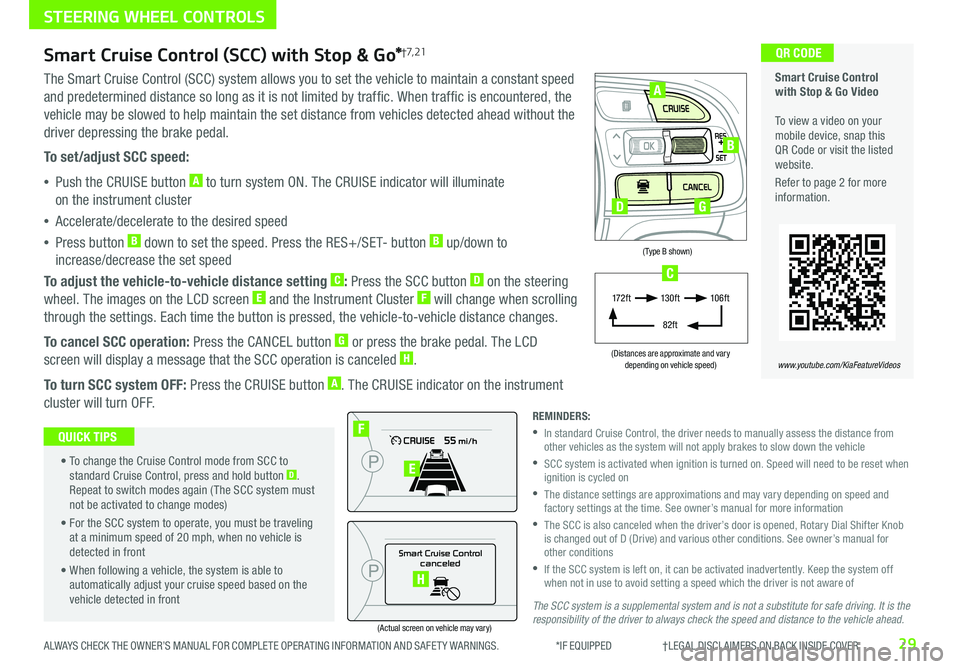brakes KIA NIRO EV 2019 Features and Functions Guide
[x] Cancel search | Manufacturer: KIA, Model Year: 2019, Model line: NIRO EV, Model: KIA NIRO EV 2019Pages: 54, PDF Size: 3.49 MB
Page 7 of 54

5ALWAYS CHECK THE OWNER’S MANUAL FOR COMPLETE OPER ATING INFORMATION AND SAFET Y WARNINGS . *IF EQUIPPED Ready indicator light
– Illuminates when the vehicle is ready
to drive . When the ready indicator light is OFF or blinking, a
malfunction has occurred . Have an authorized Kia dealer address
the concern as soon as possible .
EV S ervice w arninglight – Illuminates when there is a
malfunction related to the electric vehicle control system . Have an
authorized Kia dealer address the concern as soon as possible .
Power
d own w arning light – Illuminates w hen the power is
limited for the safety of the electric vehicle .
Charging indicator light
– Shows the charging status of the high-
voltage battery . When charging, the red
indicator turns on . When charging is complete, the green indicator turns on .
High-voltage battery level w a
rning light – Illuminates when the
high-voltage battery charge level is insufficient .
Rege
nerative b rake w arning lights (when both indicators
are
l it) – Illuminates when the regenerative brake system is not
functioning c orrectly .
Electric Vehicle (EV) Indicators
A State of Charge (SOC) gauge
The State of Charge gauge displays the high-voltage battery
charge status .
• L (low) position on the gauge indicates that the driving battery
energy is low
•H (high) position on the gauge indicates that the driving battery
is fully charged
B Power/Charge
Niro EV’s Power/Charge gauge provides information on the energy
consumption rate of the vehicle and the charge status of the regenerative
brakes .
• POWER – Shows the energy consumption rate of the vehicle when
driving uphill or accelerating . T he more electric energy used, the higher
the gauge level
•CHARGE – Shows the charging status of the battery when it is being
charged by the regenerative brakes . The more electric energy charged,
the lower the gauge level
C Distance to Empty
Distance to empty is the estimated distance the vehicle can be driven
with the remaining high-voltage battery level . I t is displayed differently
according to the selected drive mode .
INSTRUMENT CLUSTER
Page 14 of 54

12*IF EQUIPPED NIRO EV FEATURES & FUNCTIONS GUIDE
Regenerative Braking with Paddle Shifters
The regenerative braking system charges the battery when
coasting or when you use the brakes to stop the vehicle .
Use the paddle shifters to adjust the regenerative braking
level from 0 to 3 during decelerating or braking . The level
will be displayed on the instrument cluster C .
•Pull the left paddle shifter A to
increase regenerative braking
and deceleration
•Pull the right paddle shifter B to
decrease regenerative braking
and deceleration
The paddle shifters do not operate when:
•Both paddle shifters are pulled at the same time
•The vehicle is decelerating by depressing the brake pedal
•Cruise Control or Smart Cruise Control (SCC) is active
Brake and Hold System
The Brake and Hold System (one-pedal driving) increases the regenerative braking amount
to above level 3 and enables you to come to a full stop by pulling down the left paddle .
•Pull and hold the left paddle shifter A while coasting
•When the vehicle speed is above 1 .9 mph, release the left paddle shifter A for less
than 0 .5 seconds to return to the previously set level of regenerative braking
•When the vehicle speed is below 1 .9 mph, the brake and hold system stops the vehicle
even though the left paddle shifter is released
•While one-pedal driving is active, the driver can control the vehicle stopping position
using the accelerator pedal
REMINDER: The driver’s seat belt must be fastened to operate one-pedal driving .
Do not solely rely on one-pedal driving to stop the vehicle, as it may not be able to stop the vehicle depending on vehicle and road conditions. Pay attention to the road condition ahead and apply the brake if necessary.
Smart Regeneration System
This system automatically adjusts the regenerative braking
level based on a vehicle being detected in front of the Niro EV .
•Activate Smart Regeneration in the User Settings mode .
AUTO D will be displayed on the instrument cluster . AUTO
regenerative brake adjusts regenerative braking based on
the distance with the vehicle in front and its speed
•Pull and hold the right paddle shifter B for more than
1 second to turn on/off the automatic change of the
regenerative braking
Smart Regeneration is a supplemental system for the driver’s convenience. Do not solely rely on this system to stop the vehicle or avoid collisions. Always cautiously look ahead to prevent unexpected or sudden situations.
For more information on regenerative braking, one-pedal driving or the Smart Regeneration System, please refer to your Owner’s Manual.
AB
4010 0
60
80160
60140
80 120
100
kmmi
mi
RANGE
68
°c
CRUISE 60 mi/hECO
44444 mi
150
240
km/h
MPH
electric
L V .3RN D
L H
40
10 0
60
80160
60140
80 120
100
kmmi
mi
RANGE
68
°c
CRUISE 60 mi/hECO
44444 mi
150
240
km/h
MPH
electric
AUTORN D
L H
C
D
ELECTRIC VEHICLE (EV) FEATURES
Page 22 of 54

20NIRO EV FEATURES & FUNCTIONS GUIDE*IF EQUIPPED †LEGAL DISCL AIMERS ON BACK INSIDE COVER
Forward Collision-Avoidance Assist Video
To view a video on your mobile device, snap this QR Code or visit the listed website .
www.youtube.com/KiaFeatureVideos
QR CODE
DRIVER'S PANEL
Forward Collision-Avoidance Assist (FCA) / Forward Collision Warning (FCW)*†7
The FCA system is designed to help alert the driver, and, under certain conditions, apply emergency braking,
when approaching a vehicle that is slowing down, braking or stopped . Initially, FCA provides Forward Collision
Warning (FCW ) when it detects a potential collision with a vehicle in front, emitting an audible warning and visual
alert on the instrument cluster .
Adjust the alert settings (Early, Normal, Late) in the User Settings . To turn FCA /FCW off, go to User Settings again and
turn it off .
If the collision risk increases and other conditions are met, Forward Collision-Avoidance Assist (FCA) is designed to
automatically apply the brakes to reduce your speed, potentially helping to minimize the effects of a possible collision .
FCA can be turned ON in the User Settings menu on the Instrument Cluster display .
FCA /FCW will become active when the:
• Engine Start /Stop button is ON
• Vehicle is traveling more than 5 mph
• Electronic Stability Control (ESC) is ON
Forward Collision-Avoidance Assist (FCA) / Forward Collision Warning (FCW)* are not substitutes for safe and proper driving. Always drive safely and use caution. FCA / FCW may not always alert the driver when the vehicle is approaching another vehicle.
REMINDERS:
• FCA will be activated by default when vehicle power is cycled on, even when previously set to off
• FCW will not operate when the vehicle is traveling faster than approximately 50 mph
• If FCA is operating and ESC (Electronic Stability Control) is turned of f, the FCA system is automatically turned off
• When FCA is not operating, the FCA warning indicator will illuminate on the Instrument Cluster
Page 23 of 54

21ALWAYS CHECK THE OWNER’S MANUAL FOR COMPLETE OPER ATING INFORMATION AND SAFET Y WARNINGS . *IF EQUIPPED †LEGAL DISCL AIMERS ON BACK INSIDE COVER
Electronic Stability Control (ESC)†9
The ESC system is designed to help stabilize the vehicle during certain
cornering maneuvers . It is a good idea to keep ESC turned ON whenever
possible .
Press ESC OFF button B to disable Traction Control in ESC (ESC OFF
indicator will illuminate) .
To turn both Traction Control and Stability Control off, press and hold ESC
OFF button B (ESC OFF indicator will illuminate, and an alert sounds) .
REMINDERS:
•ESC is active by default at vehicle startup
•
The ESC Indicator Light in the instrument cluster will illuminate whenever the ESC is in operation
For more information on Electronic Stability Control (ESC) and its specific features and operations, please refer to your Owner’s Manual.
HAC does not replace the need to apply brakes while the vehicle is stopped on an incline.
Instrument Cluster Control
Press switch A up or down to
adjust display brightness of the
instrument panel illumination .
Hill-Start Assist Control (HAC)†9
The HAC system is designed to help prevent the vehicle from rolling
backward when accelerating from a stop while on a steep incline .
The HAC system automatically activates whether the ESC is OFF or ON but
does NOT activate when the ESC has malfunctioned .
REMINDERS:
•
The HAC system does not operate when the Rotary Dial Shifter Knob is in the P (Park) or the N (Neutral) position
•In the event of an HAC system malfunction, see an Authorized Kia Dealer for service
•
•When HAC is active (e .g ., accelerating from a stop on an incline), you may notice that the brakes will momentarily remain engaged after you depress the accelerator . This is normal HAC operation
•HAC provides a two-second delay before the vehicle may start rolling backward
QUICK TIPS
AUTO
OFF
(Buttons are located left of the Steering Wheel)
AUTO
OFF
BA
DRIVER'S PANEL
Page 31 of 54

29ALWAYS CHECK THE OWNER’S MANUAL FOR COMPLETE OPER ATING INFORMATION AND SAFET Y WARNINGS . *IF EQUIPPED †LEGAL DISCL AIMERS ON BACK INSIDE COVER
(Type B shown)
(Distances are approximate and vary depending on vehicle speed)
(Actual screen on vehicle may vary)
The SCC system is a supplemental system and is not a substitute for safe driving. It is the responsibility of the driver to always check the speed and distance to the vehicle ahead.
STEERING WHEEL CONTROLS
Smart Cruise Control with Stop & Go Video To view a video on your mobile device, snap this QR Code or visit the listed website .
Refer to page 2 for more information .
www.youtube.com/KiaFeatureVideos
QR CODE
Smart Cruise Control
canceled
F
E
H
A
B
D
17 2 f t13 0 f t
82ft
10 6 f t
C
G
Smart Cruise Control (SCC) with Stop & Go*†7, 21
The Smart Cruise Control (SCC) system allows you to set the vehicle to maintain a constant speed
and predetermined distance so long as it is not limited by traffic . When traffic is encountered, the
vehicle may be slowed to help maintain the set distance from vehicles detected ahead without the
driver depressing the brake pedal .
To set/adjust SCC speed:
•Push the CRUISE button A to turn system ON . The CRUISE indicator will illuminate
on the instrument cluster
•Accelerate/decelerate to the desired speed
•Press button B down to set the speed . Press the RES+/SET- button B up/down to
increase/decrease the set speed
To adjust the vehicle-to-vehicle distance setting C: Press the SCC button D on the steering
wheel . The images on the LCD screen E and the Instrument Cluster F will change when scrolling
through the settings . Each time the button is pressed, the vehicle-to-vehicle distance changes .
To cancel SCC operation: Press the CANCEL button G or press the brake pedal . The LCD
screen will display a message that the SCC operation is canceled H .
To turn SCC system OFF: Press the CRUISE button A . The CRUISE indicator on the instrument
cluster will turn OFF .
• To change the Cruise Control mode from SCC to standard Cruise Control, press and hold button D . Repeat to switch modes again ( The SCC system must not be activated to change modes)
• For the SCC system to operate, you must be traveling at a minimum speed of 20 mph, when no vehicle is detected in front
• When following a vehicle, the system is able to automatically adjust your cruise speed based on the vehicle detected in front
QUICK TIPS
REMINDERS:
•
In standard Cruise Control, the driver needs to manually assess the distance from other vehicles as the system will not apply brakes to slow down the vehicle
•
SCC system is activated when ignition is turned on . Speed will need to be reset when ignition is cycled on
•
The distance settings are approximations and may vary depending on speed and factory settings at the time . See owner’s manual for more information
•
The SCC is also canceled when the driver’s door is opened, Rotary Dial Shifter Knob is changed out of D (Drive) and various other conditions . See owner’s manual for other conditions
•
If the SCC system is left on, it can be activated inadvertently . Keep the system off when not in use to avoid setting a speed which the driver is not aware of
Page 54 of 54

*IF EQUIPPED
(up to 60,000 miles)AMAINTENANCE INTERVALS (MILES)
MAINTENANCE ITEMS7, 5 0 015,00022,50030,0003 7, 5 0 045,00052,50060,000
Rotate tires (every 6,500 miles)PPPPPPPP
Climate control air filter‡IIIRIIIR
12V battery conditionIIIIIIII
Steering gear rack, linkage & bootsIIIIIIII
Air conditioner refrigerant (compressor‡)IIIIIIII
Brake fluidIIIIIIII
Brake lines, hoses and connectionsIIIIIIII
Disc brakes and padsIIIIIIII
Brake pedalIIIIIIII
Drive shafts and bootsIIII
Suspension ball boltsIIII
Reduction Gear OilIII
NIRO EV NORMAL MAINTENANCE SCHEDULE P=Perform • R=Replace • I=InspectB
‡ If equipped.A . See the Owner’s Manual for complete maintenance schedule.B. And, if necessary, adjust, correct, clean or replace.See your Owner’s Manual for more details and complete maintenance information, including severe maintenance schedule. Warranty may be voided if maintenance schedule is not followed.
Check your Maintenance Schedule or schedule an appointment with a dealer using your UVO link account by logging into your Kia Access with UVO link App or your account on MyUVO.com (See page 32 for setup information)
QUICK TIP
Part Number: UB190-PS-004†LEG AL DISCL AIMERS ON BACK INSIDE COVER© 2019 Kia Motors America, Inc. All rights reserved.Consumer - Roadside Assistance†15: 1-800-333-4KIA (4542)